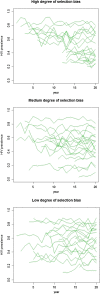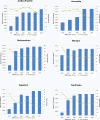A comparison of missing data procedures for addressing selection bias in HIV sentinel surveillance data
- PMID: 23883362
- PMCID: PMC3724705
- DOI: 10.1186/1478-7954-11-12
A comparison of missing data procedures for addressing selection bias in HIV sentinel surveillance data
Abstract
Background: Selection bias is common in clinic-based HIV surveillance. Clinics located in HIV hotspots are often the first to be chosen and monitored, while clinics in less prevalent areas are added to the surveillance system later on. Consequently, the estimated HIV prevalence based on clinic data is substantially distorted, with markedly higher HIV prevalence in the earlier periods and trends that reveal much more dramatic declines than actually occur.
Methods: Using simulations, we compare and contrast the performance of the various approaches and models for handling selection bias in clinic-based HIV surveillance. In particular, we compare the application of complete-case analysis and multiple imputation (MI). Several models are considered for each of the approaches. We demonstrate the application of the methods through sentinel surveillance data collected between 2002 and 2008 from India.
Results: Simulations suggested that selection bias, if not handled properly, can lead to biased estimates of HIV prevalence trends and inaccurate evaluation of program impact. Complete-case analysis and MI differed considerably in their ability to handle selection bias. In scenarios where HIV prevalence remained constant over time (i.e. β = 0), the estimated β^1 derived from MI tended to be biased downward. Depending on the imputation model used, the estimated bias ranged from -1.883 to -0.048 in logit prevalence. Furthermore, as the level of selection bias intensified, the extent of bias also increased. In contrast, the estimates yielded by complete-case analysis were relatively unbiased and stable across the various scenarios. The estimated bias ranged from -0.002 to 0.002 in logit prevalence.
Conclusions: Given that selection bias is common in clinic-based HIV surveillance, when analyzing data from such sources appropriate adjustment methods need to be applied. The results in this paper suggest that indiscriminant application of imputation models can lead to biased results.
Figures
Similar articles
-
Correcting for selection bias in HIV prevalence estimates: an application of sample selection models using data from population-based HIV surveys in seven sub-Saharan African countries.J Int AIDS Soc. 2022 Aug;25(8):e25954. doi: 10.1002/jia2.25954. J Int AIDS Soc. 2022. PMID: 35929226 Free PMC article.
-
Studying dynamics of the HIV epidemic: population-based data compared with sentinel surveillance in Zambia.AIDS. 1998 Jul 9;12(10):1227-34. doi: 10.1097/00002030-199810000-00015. AIDS. 1998. PMID: 9677172
-
Comparing single and multiple imputation strategies for harmonizing substance use data across HIV-related cohort studies.BMC Med Res Methodol. 2022 Apr 3;22(1):90. doi: 10.1186/s12874-022-01554-4. BMC Med Res Methodol. 2022. PMID: 35369872 Free PMC article.
-
Review: a gentle introduction to imputation of missing values.J Clin Epidemiol. 2006 Oct;59(10):1087-91. doi: 10.1016/j.jclinepi.2006.01.014. Epub 2006 Jul 11. J Clin Epidemiol. 2006. PMID: 16980149 Review.
-
A review of the use of controlled multiple imputation in randomised controlled trials with missing outcome data.BMC Med Res Methodol. 2021 Apr 15;21(1):72. doi: 10.1186/s12874-021-01261-6. BMC Med Res Methodol. 2021. PMID: 33858355 Free PMC article. Review.
Cited by
-
Analytical methods used in estimating the prevalence of HIV/AIDS from demographic and cross-sectional surveys with missing data: a systematic review.BMC Med Res Methodol. 2020 Mar 14;20(1):65. doi: 10.1186/s12874-020-00944-w. BMC Med Res Methodol. 2020. PMID: 32171240 Free PMC article.
-
Opportunities for Enhanced Strategic Use of Surveys, Medical Records, and Program Data for HIV Surveillance of Key Populations: Scoping Review.JMIR Public Health Surveill. 2018 May 22;4(2):e28. doi: 10.2196/publichealth.8042. JMIR Public Health Surveill. 2018. PMID: 29789279 Free PMC article.
References
-
- WHO. Towards universal access: scaling up priority HIV/AIDS interventions in the health sector. Geneva; 2010. (progress report 2010).
-
- UNAIDS. Scaling up access to HIV prevention, treatment, care and support: the next steps. 2006.
-
- UNAIDS. AIDS epidemic update: special report on HIV prevention. 2005.
-
- Gouws E, Mishra V, Fowler TB. Comparison of adult HIV prevalence from national population-based surveys and antenatal clinic surveillance in countries with generalised epidemics: implications for calibrating surveillance data. Sex Transm Infect. 2008;84:i17–i23. doi: 10.1136/sti.2008.030452. - DOI - PMC - PubMed
-
- Walker N, Garcia-Calleja JM, Heaton L, Asamoah-Odei E, Poumerol G, Lazzari S, Ghys PD, Schwartländer B, Stanecki KA. Epidemiological analysis of the quality of HIV sero-surveillance in the world: how well do we track the epidemic? AIDS. 2001;15:1545–1554. doi: 10.1097/00002030-200108170-00012. - DOI - PubMed
LinkOut - more resources
Full Text Sources
Other Literature Sources



